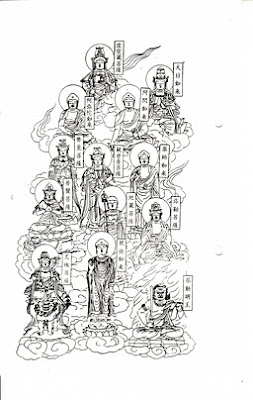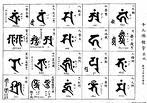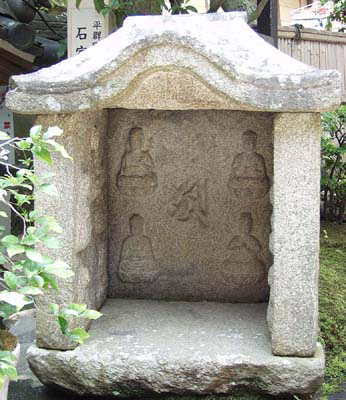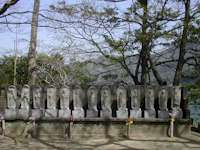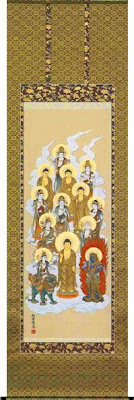:::::::::::::::::::::::::::::::::::::::::::::::::::::::::::::::::::::::::::::::::::::::::::::::::::::
Takahata Fudo Temple 高幡不動尊
Takahatafudō
28 高幡山 明王院 金剛寺 Nr. 28 on the Buso Fudo Pilgrimage.
09 on the Kanto (Bando) Fudo Pilgrimage)

source : jyohorecipe.com
The Takahata-san Myoo-in Kongo-ji Temple of the Shingon-shu Chizan-ha (Chizan division of Shingon Sect) Bekkaku Honzan (Extra-status Cathedral), is called Takahata Fudo-son Temple and counted among the Kanto region's 3 major temples dedicated to Fudo Myoo (Acala Vidyaraja). The temple contains a lot of cultural assets, some of which are designated as Important Cultural Assets.
In the hall of five-story pagoda there is Kobo Daishi (Kooboo Daishi) and 1000 Jizo Statues (sentai Jizoo 千躰地蔵).

- quote
Takahatafudoson Kongo-ji Temple
The official name of this temple is Shingon-shu Chisan-ha Bekkaku-honzan Takahata-san Myo'o-in Kongo-ji (Shingon Sect Chisan School Quasi-Head Temple, Mt. Takahata Myo'o-in Hall Kongo-ji Temple).
Eleven-hundred years ago, in the early part of Japan's Heian Period (794-1185), Jikaku Daishi Ennin, at the request of Emperor Seiwa, proclaimed this land a holy site, built Fudo-do Hall and dedicated it to the Buddhist deity called Fudo-myo'o in Japanese and better known as Acala in English.
In addition to hosting seasonal events such as the Hydrangea Festival, Chrysanthemum Festival and Autumm Leaves Festival, the temple also attracts visitors year-round for being the site of Bodai-ji Temple, which is dedicated to Hijikata Toshizo and his deceased descendants. Hijikata was a military leader who helped Japan modernize in the transition from feudalism known as the Meiji Restoration of 1868.
- source : www.tama-monorail.co.jp
- quote -
Takahata Fudō-dō 高幡不動堂 Takahata Fudo Hall
It is said that 高幡山明王院金剛寺 Takahata-zan Myōo-in Kongō-ji Temple
was founded during the Taihō era (701-704) or in the Nara period.
During the Edo period, this temple was counted as
one of 関東十一檀林 the 11 Kantō Buddhist seminaries
and was widely worshipped by the populace as the fire deity which prevents fires.
- source : Tokyo Metropolitan Museum -
- - - - - Major annual Festivals
The Mame-maki Festival (Setsubun) in February, where some celebrities and people born in the year of the same sign of the Chinese zodiac as the current year throw beans to chase away demons.
The Ajisai (Hydrangea) Festival, held from early June to early July, exhibits over 7,500 ajisai flowers blooming peacefully under the rainy-season skies.
The Chrysanthemum Festival (Kiku Matsuri), held from late October to middle November, displays more than 2,000 works of flower art by chrysanthemum loving artists from the Tama region.

http://www.tourism.metro.tokyo.jp/italian2/spot/hino1.html
:::::::::::::::::::::::::::::::::::::::::::::::::::::::::::::::::::::::::::::::::::::::::::::::::::::
The Great Daruma Market
It is said that the origin of the temple traces back to the early Heian period when the Emperor Seiwa commanded to place a Fudo Myoo (Acala Vidyaraja) to protect the district of eastern Kanto. Samurai Generals worshiped it during Sengoku period in the Muromachi and later eras, and then it became widely worshiped in the commonalty as the guardian deity of fire defense in the Edo period.

A grand festival will be carried out on the 28th of January as the first Fudo fair (Hatsu Fudo) this year (the 28th of each month is fixed as a fair of Fudo). Various Dharma dolls in the Kanto area are sold at bustling outdoor stalls. 100,000 worshippers visit the fair and 150 stalls lined in the precinct of the temple on the day.
http://www.tourism.metro.tokyo.jp/english/topics/040129/2.html
................... 高幡不動のだるま市 Daruma market

関東の目無しだるまは、初めに片目を墨で書き入れ、願望成就のときに残りの目を入れます。達磨寺をはじめ各地の社寺で正月・縁日にだるま市が立つ。毎年大きくしていく慣わしがあります。 今回、4時間休暇を取って、東京都日野市の高幡不動のだるま市に行ってきました。1月28日の初不動がだるま市です。だるまがごろごろ並んでいるのはいいものです。私は、はじめてだるま市に行き、はじめてだるまを買いました。張子のだるまで、身長25cmくらいのやつで、まあまあの大きさです。これから大きくしていこう。
http://www.geocities.jp/kuuu2004/takahata.html
Click for more Pictures

:::::::::::::::::::::::::::::::::::::::::::::::::::::::::::::::::::::::::::::::::::::::::::::::::::::
The Main Homepage of the Temple in Japanese
..................... The Temple Compounds
This Fudo is also called the
"sweating Fudo", asekaki Fudo 汗かき不動.
During the Muromachi period, whenever there was a major fight in the country, this wooden statue would start sweating sacred sweat 霊汗. So it was widely revered by the warriours.
This Fudo was also a protector of fires for the town of Edo.

真言宗智山派別格本山、高幡山明王院金剛寺は古来関東三不動の一つに挙げられ高幡不動尊として親しまれている。その草創は古文書によれば大宝年間(701)以前とも或いは奈良時代行基菩薩の開基とも伝えられるが、今を去る1100年前、平安時代初期に慈覚大師円仁が、清和天皇の勅願によって当地を東関鎮護の霊場と定めて山中に不動堂を建立し、不動明王をご安置したのに始まる。のち建武2年(1335)8月4日夜の大風によって山中の堂宇が倒壊したので、時の住僧儀海上人が康永元年(1342)麓に移し建てたのが現在の不動堂で関東稀に見る古文化財である。続いて建てられた仁王門ともども重要文化財に指定されている。足利時代の高幡不動尊は「汗かき不動」と呼ばれて鎌倉公方をはじめとする戦国武将の尊祟をあつめ、江戸時代には関東十一檀林に数えられ、火防の不動尊として広く庶民の信仰をあつめた。当時門末三十六ケ寺を従え、関東地方屈指の大寺院であったが安永8年の業火により大日堂をはじめ大師堂、山門、客殿、僧坊等を一挙に焼失した。その後、歴代住持の営々たる努力により徐々に復興に向ったが殊に昭和50年代以降五重塔・大日堂・鐘楼・宝輪閣・大回廊・奥殿等の工事が相継ぎ往時を凌ぐ程の寺観を呈するようになった。

総重量1100キロを超える巨像で古来日本一と伝えられた重文丈六不動三尊は此の度千年ぶりの修復作業が完了し現在奥殿にご安置されている。
http://www.takahatafudoson.or.jp/index_sannai.html
- - - Talismans - Omamori 御守り - sold at the Temple


- www.takahatafudoson.or.jp

....................................................................................................................
The Face of Fudo Myo-O 不動明王のお顔

Festival of 10000 Lights, Mantoo-E
万燈会

About the Star Festival Hoshi Matsuri 星まつりってなに?
高幡不動尊はじめ、寺社の行事リストなどで時折目にする星まつり。やけにメルヘンな響き。お不動様とミスマッチのような気さえしますが、日本でも昔から占星術は盛んでした。
星や太陽や月の動きなどで、個人の運命や社会の運勢を占っていたのです。特に北斗七星は寿命を司るものとして、北辰とも妙見とも呼ばれ、崇拝されてきました。占星術では、人の運命や運勢が生まれた星によって決まるとされ、節分などの季節の変わり目に運勢が変わるともいわれました。
このことから、真言宗では北斗七星の化身である妙見菩薩を供養し、厄除けと福を招くため法要を行ったのです。これが今も続く星まつりで、冬至や節分など、季節の変わり目に行われています。
http://www.tama-monorail.co.jp/newspaper/04.12.11/fudo/
..........................................................................................................

kai-un soba 開運そば Buckwheat Noodles for Good Luck
東京都日野市高幡149 Kaiun Soba Shop
.............................................................................

The Hydrangea Festival Ajisai Matsuri 紫陽花祭り
....................................................................................................................

source : humsum.exblog.jp
Jizo Bosatsu 地蔵
:::::::::::::::::::::::::::::::::::::::::::::::::::::::::::::::::::::::::::::::::::::::::::::::::::::
松杉や枯野の中の不動堂
matsu sugi ya kareno no naka no Fudōdō (Fudoo doo)
pines and cedars -
in the withered fields
the Hall of Fudo
. Masaoka Shiki at Takahata Fudo Hall .
:::::::::::::::::::::::::::::::::::::::::::::::::::::::::::::::::::::::::::::::::::::::::::::::::::::
.......................................Further Reading
Festival of 10000 Lights, Mark Schumacher
http://www.onmarkproductions.com/html/ishidoro.shtml
Daruma Markets in Japan, Gabi Greve
Daruma Ichi - Daruma Markets in Japan
The Star Shrines and Star Festivals, Gabi Greve
Daruma Pilgrims in Japan: Star Shrines (Hoshi Jinja)
:::::::::::::::::::::::::::::::::::::::::::::::::::::::::::::::::::::::::::::::::::::::::::::::::::::
The stone Fudo at the Japan Temple Nihon-Ji in Chiba starts sweating to make up for the sins of mankind.
日本寺 Nihon-Ji and more . . .
. asekaki Fudo 汗かき不動 / あせかき不動
sweating Fudo - Introduction .
:::::::::::::::::::::::::::::::::::::::::::::::::::::::::::::::::::::::::::::::::::::::::::::::::::::
While we are at it, here is another sweating deity.
Asekaki Kannon 汗かき観音
岩間山 正法寺(岩間寺)Temple Shobo-Ji, Iwamadera
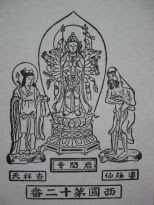
. Shoobooji 岩間山正法寺 Shobo-Ji .
.......................................................................

source : facebook - Takatoshi Goto
Asekaki Amida 汗かき阿弥陀 sweating Amida
一向寺 銅造阿弥陀如来坐像
. Amida Nyorai 阿弥陀如来 .
:::::::::::::::::::::::::::::::::::::::::::::::::::::::::::::::::::::::::::::::::::::::::::::::::::::
Asekaki Jizoo, the Sweating Jizo 汗かき地蔵
external LINK
:::::::::::::::::::::::::::::::::::::::::::::::::::::::::::::::::::::::::::::::::::::::::::::::::::::
. 武相不動尊二十八所 - Busoo - Buso Pilgrims
Musashino and Sagami - 28 temples .
. 関東三十六不動霊場
Pilgrimages to 36 Fudo Temples in Kanto (Bando) .
[ . BACK to DARUMA MUSEUM TOP . ]
[ . BACK to WORLDKIGO . TOP . ]
:::::::::::::::::::::::::::::::::::::::::::::::::::::::::::::::::::::::::::::::::::::::::::::::::::::

